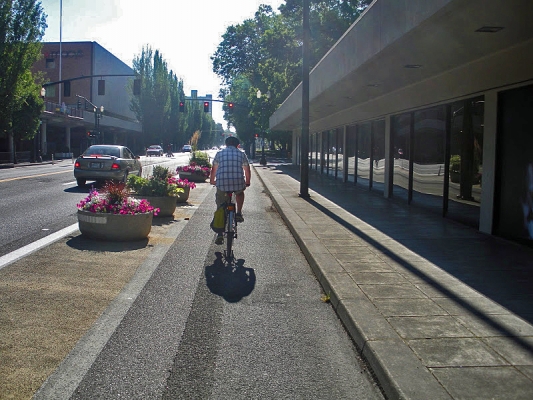Professor John Pucher, a car-less commuter from the Bloustein School of Planning and Public Policy at Rutgers University, was the first fall OTREC Visiting Scholar and CTS Seminar guest on September 28, 2007. His presentation, "Promoting Safe Walking and Cycling to Improve Public Health: Lessons from Europe," was standing room only, and the audience enjoyed his photos of bike-friendly features in cities across Europe. Pucher examined a range of public health impacts of our urban transport systems and argued that the current car dependence of American cities is responsible for enormous environmental harm, social isolation, lack of physical activity, and traffic dangers. He described how improving the convenience, safety, and attractiveness of walking and cycling in crucial to overcoming these negative impacts. Pucher discussed specific policies and programs used in Europe, and advocates their widespread adoption in American cities. A lively discussion with faculty, students and members of the Portland Bicycle Master Plan Committee followed the seminar.
The video begins at 1:32.
Topic: Four Types of Cyclists: What do we know and how can it help?
Labeling or categorizing cyclists has been occurring for over a century for a variety of purposes. Dr. Dill's research aimed to examine a typology developed by the City of Portland that includes four categories: Strong and the Fearless, Enthused and Confident, Interested but Concerned, and No Way No How. Unlike several other typologies, this widely referenced typology is intended to apply to all adults, regardless of their current cycling behavior. This seminar will present her findings, focusing on differences between the four types and a better understanding the market for increasing cycling for transportation.
PRESENTATION ARCHIVE
OVERVIEW
Planners and decision makers have increasingly voiced a need for network-wide estimates of bicycling activity. Such volume estimates have for decades informed motorized planning and analysis but have only recently become feasible for non-motorized travel modes.
Recently, new sources of bicycling activity data have emerged such as Strava, Streetlight, and GPS-enabled bike share systems. These emerging data sources have potential advantages as a complement to traditional count data, and have even been proposed as replacements for such data, since they are collected continuously and for larger portions of local bicycle networks. However, the representativeness of these new data sources has been questioned, and their suitability for producing bicycle volume estimates has yet to...
Read moreWatch video
Slides are not available for this presentation.
During the March 2011 earthquake/ tsunami/nuclear disaster, the internet filled with stories of how something quite ordinary in Japanese life became an important lifeline—the bicycle. For example an 83-year-old woman escaped the tsunami by bicycle, and due to public-transport disruptions, bicycle stores sold out of bicycles as quickly as supermarkets sold out of food. However not just in disasters, but in daily life, the most reliable, sustainable form of transportation, next to walking, is via Japan’s estimated 80,000,000 bicycles, affectionately called mamachari.
This illustrated presentation, based on four-years of cultural-landscape research culminating the publication of世界が称賛した日本の町の秘密 (Secrets of Japanese Cities the World Admires. Tokyo: Yousensha, 2011), begins by discussing why mamachari are perfect for local transportation and the many practical ways Japanese use them. It then explores why many of Japan’s densely populated, fine-grained neighborhoods with auto-resistant narrow streets and nearby shopping, make ideal bicycle neighborhoods. Issues explored will include the mamachari’s impact on: neighborhood livability; sustainability; public health through active transportation; fostering direct human contact not possible with motor-car travel; and maintaining the compact human scale of communities by...
Read moreSummary: The most recent edition of the Highway Capacity Manual (HCM) contains analysis procedures for measuring the level-of-service (LOS), also referred to as quality of service, provided by an urban roadway to bicyclists. The method uses different design and operating features of the roadway segment (e.g. width, motor vehicle volumes and speeds) to assess an LOS grade of A (best) to F (worst). These procedures are used by planners and engineers to recommend how existing streets could be retrofitted or new streets designed to better serve people on bicycles (and other modes). However, the current HCM does not include methods that address protected bike lanes (aka “cycle tracks” or “separated bike lanes”), only conventional striped bike lanes, shoulders, and shared streets. There are other methods for predicting comfort from a bicyclist’s perspective that do consider protected bike lanes, but they are either based only on expert opinion or on surveys in Denmark.
This presentation will describe how to evaluate the level-of-service of a protected bike lane using results from surveys conducted in the United States. The model developed by this project could be used to supplement the current HCM to objectively consider a wider...
Read moreThe video begins at 0:27.
Dr. Kelly Clifton, associate professor of Civil and Environmental Engineering at PSU, will present results from Clifton's recent study that aims to make connections between our travel choices and our consumer behavior. Based upon a survey administered in the Portland metro area in the summer 2011, the analysis examines the various influences on mode choices to local restaurants. Similarly, patron spending and frequency of visits are also analyzed with respect to mode to better understand these complex relationships. In this talk, there will be an emphasis on comparing patrons that choose non-automobile modes to those who take a private vehicle. These findings are useful as communities around the country try to educate the business community about the potential impacts of investments in cycling, pedestrians and transit.
View slides


